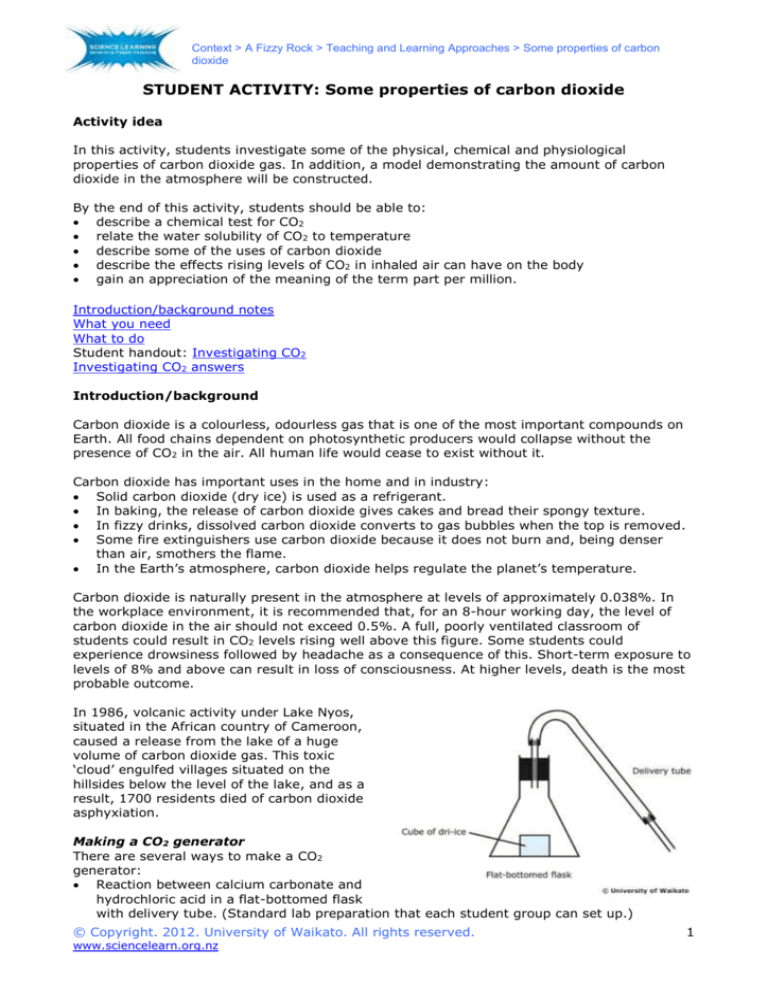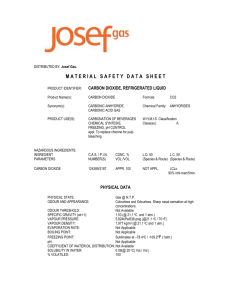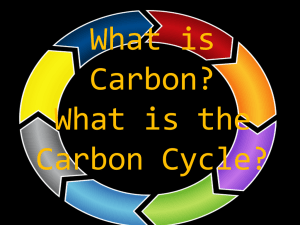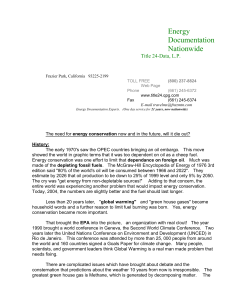
Context > A Fizzy Rock > Teaching and Learning Approaches > Some properties of carbon
dioxide
STUDENT ACTIVITY: Some properties of carbon dioxide
Activity idea
In this activity, students investigate some of the physical, chemical and physiological
properties of carbon dioxide gas. In addition, a model demonstrating the amount of carbon
dioxide in the atmosphere will be constructed.
By
the end of this activity, students should be able to:
describe a chemical test for CO2
relate the water solubility of CO2 to temperature
describe some of the uses of carbon dioxide
describe the effects rising levels of CO2 in inhaled air can have on the body
gain an appreciation of the meaning of the term part per million.
Introduction/background notes
What you need
What to do
Student handout: Investigating CO2
Investigating CO2 answers
Introduction/background
Carbon dioxide is a colourless, odourless gas that is one of the most important compounds on
Earth. All food chains dependent on photosynthetic producers would collapse without the
presence of CO2 in the air. All human life would cease to exist without it.
Carbon dioxide has important uses in the home and in industry:
Solid carbon dioxide (dry ice) is used as a refrigerant.
In baking, the release of carbon dioxide gives cakes and bread their spongy texture.
In fizzy drinks, dissolved carbon dioxide converts to gas bubbles when the top is removed.
Some fire extinguishers use carbon dioxide because it does not burn and, being denser
than air, smothers the flame.
In the Earth’s atmosphere, carbon dioxide helps regulate the planet’s temperature.
Carbon dioxide is naturally present in the atmosphere at levels of approximately 0.038%. In
the workplace environment, it is recommended that, for an 8-hour working day, the level of
carbon dioxide in the air should not exceed 0.5%. A full, poorly ventilated classroom of
students could result in CO2 levels rising well above this figure. Some students could
experience drowsiness followed by headache as a consequence of this. Short-term exposure to
levels of 8% and above can result in loss of consciousness. At higher levels, death is the most
probable outcome.
In 1986, volcanic activity under Lake Nyos,
situated in the African country of Cameroon,
caused a release from the lake of a huge
volume of carbon dioxide gas. This toxic
‘cloud’ engulfed villages situated on the
hillsides below the level of the lake, and as a
result, 1700 residents died of carbon dioxide
asphyxiation.
Making a CO2 generator
There are several ways to make a CO2
generator:
Reaction between calcium carbonate and
hydrochloric acid in a flat-bottomed flask
with delivery tube. (Standard lab preparation that each student group can set up.)
© Copyright. 2012. University of Waikato. All rights reserved.
www.sciencelearn.org.nz
1
Context > A Fizzy Rock > Teaching and Learning Approaches > Some properties of carbon
dioxide
Small piece of dry ice placed in a flat-bottomed flask and delivery tube. (Care is needed in
handling the dry ice, but with this method, it leads to a discussion about the various states
of carbon dioxide and their uses.)
A bottle of Coke (chilled and just over half
full) fitted with a one-hole bung and delivery
tube. By gently shaking the bottle, a stream
of CO2 can be generated. (Each student group
can bring in their own bottle of Coke, and this
leads to a discussion about carbonated drinks
and the solubility of CO2.)
What you need
Copies of the student handout Investigating
CO2
CO2 generator (see above)
Glass boiling tubes and bungs to fit
100 mL glass beakers
Crushed ice
Stirring rod thermometer
Limewater
Bromothymol blue indicator
Small candle
1 kg pack of rice (class demonstration)
Weighing balance
Food colouring
Large tray
What to do
1. Hand out copies of the student handout and discuss. Assist students to carry out the first
three investigations and complete the worksheet:
Solubility of CO2 in water at various temperatures
Chemical test for CO2
Density of CO2 and its effect on a candle flame
How much CO2 in the air? (Teacher demonstration)
2. Mark out a 900 x 600 mm area on a lab benchtop or use a suitable sized tray. Pour the
contents of a 1 kg bag of rice onto the area and spread the grains over the whole area.
Take 20 of the grains and colour them red using a felt-tip pen. Place them back in the pile
and mix the grains up. Explain that, at 0.038% of the Earth’s atmosphere, this is a pictorial
representation of the level of CO2 in the air.
3. To show all the atmospheric gases present
in air at sea level on a typical early summer
day, take a 1 kg packet of white rice (about
50,000 rice grains) and weigh out into
separate containers each of the following
amounts, soak in food colouring and allow to
dry.
N2 – 758.8 g (off white)
O2 – 203.6 g (yellow)
H2O – 28.2 g (blue)
Ar – 8.9 g (green)
CO2 – 0.4 g (red)
© Copyright. 2012. University of Waikato. All rights reserved.
www.sciencelearn.org.nz
2
Context > A Fizzy Rock > Teaching and Learning Approaches > Some properties of carbon
dioxide
4. Empty each container onto the tray. Thorough mixing reveals that the amount of CO 2 in the
atmosphere (represented by the red grains) is very low by comparison with other gases. It
is indeed a trace gas sitting at about 380 ppm, but an extremely important one. (It is
advisable to set up two lots of containers with the different amounts and colours. One is
used for mixing together and one to show relative amounts.)
5. Have students complete the last section of the handout and discuss.
© Copyright. 2012. University of Waikato. All rights reserved.
www.sciencelearn.org.nz
3
Context > A Fizzy Rock > Teaching and Learning Approaches > Some properties of carbon
dioxide
Student handout: Investigating CO2
Solubility of CO2 in water at various temperatures
1. Fill three boiling tubes with CO2 and stopper.
2. Two thirds fill a 100 mL beaker with water at 15°C and add 5 drops of bromothymol blue
indicator.
3. Invert one of the test tubes full of CO2 into the beaker and carefully remove the bung.
4. Rock the test tube back and forwards for several minutes, and with the rim of the test tube
touching the bottom of the beaker, note the height of water that has risen into the tube.
Note also any colour change to the water.
5. Repeat steps 1 to 4 with an ice/water mix at 0°C.
a. Compare the heights of water for each of the tubes:
15°C
0°C
__ ___ mm
______ mm
b. What do these results tell you about the solubility of carbon dioxide in water?
c. What do these results tell you about the solubility of carbon dioxide in water at various
temperatures?
d. The oceans contain a huge amount of dissolved CO2. If global warming continues and
the temperature of the oceans rises accordingly, what could happen to the atmospheric
level of CO2 gas?
e. Bromothymol blue is an acid base indicator similar to litmus paper. It is yellow in acidic
solutions and blue in neutral solutions. Did any colour changes occur in this
experiment? If so, can you explain why?
Chemical test for CO2
6. Half fill a boiling tube with limewater.
7. From the CO2 generator, slowly bubble CO2 gas through the limewater and note what
happens.
8. Continue to bubble the CO2 through the limewater and note any changes.
f.
What did you observe when the CO2 was bubbled through the limewater?
© Copyright. 2012. University of Waikato. All rights reserved.
www.sciencelearn.org.nz
4
Context > A Fizzy Rock > Teaching and Learning Approaches > Some properties of carbon
dioxide
g. On continued bubbling, did you observe any further changes?
h. If changes did occur, write word equations to show any chemical reactions taking place.
Density of CO2 and its effect on a candle flame
9. Place a small candle at the bottom of a 500 mL beaker and light it.
10. Using the CO2 generator and a length of tubing, play a jet of the gas into the beaker,
keeping the jet just below the beaker rim level to one side. Note what happens to the
candle flame.
i.
What happened to the candle flame?
j.
If there was an effect, how did the CO2 manage to reach the flame if it entered the
beaker from the top?
k. Is there a possible industrial use for CO2 based on the results of this experiment?
How much CO2 in the air? (Teacher demonstration)
l.
What does ppm stand for?
m. At about 350 ppm, what impression did you get from mixing the grains of rice about the
amount of CO2 in the air compared to other atmospheric gases?
n. Although very low, this level is extremely important. Why?
© Copyright. 2012. University of Waikato. All rights reserved.
www.sciencelearn.org.nz
5
Context > A Fizzy Rock > Teaching and Learning Approaches > Some properties of carbon
dioxide
o. The amount of one of the other gases used in this demonstration can vary quite
markedly from day to day. Which gas is this and why does it vary?
p. Exposure to high concentrations of CO2 gas can be life threatening. In 1986, volcanic
activity under Lake Nyos, situated in the African country of Cameroon, caused a release
from the lake of a huge volume of carbon dioxide gas. This toxic ‘cloud’ engulfed
villages situated on the hillsides below the level of the lake, and as a result, 1700
residents died of carbon dioxide asphyxiation. The graphic below has some information
about the toxicity of CO2.
Why it is a necessary requirement to have windows open when student groups,
experimenting in the lab, are using Bunsen burners?
© Copyright. 2012. University of Waikato. All rights reserved.
www.sciencelearn.org.nz
6
Context > A Fizzy Rock > Teaching and Learning Approaches > Some properties of carbon
dioxide
Investigating CO2 answers
Solubility of CO2 in water at various temperatures
1. Fill three boiling tubes with CO2 and stopper.
2. Two thirds fill a 100 mL beaker with water at 15°C and add 5 drops of bromothymol blue
indicator.
3. Invert one of the test tubes full of CO2 into the beaker and carefully remove the bung.
4. Rock the test tube back and forwards for several minutes, and with the rim of the test tube
touching the bottom of the beaker, note the height of water that has risen into the tube.
Note also any colour change to the water.
5. Repeat steps 1 to 4 with an ice/water mix at 0°C.
a. Compare the heights of water for each of the tubes:
15°C
0°C
__10___ mm
__20___ mm
b. What do these results tell you about the solubility of carbon dioxide in water?
Carbon dioxide is soluble in water (2 g/L at 15°C).
c. What do these results tell you about the solubility of carbon dioxide in water at various
temperatures?
The higher the temperature, the lower is the solubility.
d. The oceans contain a huge amount of dissolved CO2. If global warming continues and
the temperature of the oceans rises accordingly, what could happen to the atmospheric
level of CO2 gas?
The level could rise to be well above the current 350 ppm level.
e. Bromothymol blue is an acid base indicator similar to litmus paper. It is yellow in acidic
solutions and blue in neutral solutions. Did any colour changes occur in this
experiment? If so, can you explain why?
A colour change was observed. The change was from orange-yellow to orange-red.
Carbon dioxide is a weakly acidic gas. A small amount of the dissolved gas reacts with
water to produce a weak acid commonly known as carbonic acid.
CO2(g) + H2O(l) H2CO3(aq)
Chemical test for CO2
6. Half fill a boiling tube with limewater.
7. From the CO2 generator, slowly bubble CO2 gas through the limewater and note what
happens.
8. Continue to bubble the CO2 through the limewater and note any changes.
f.
What did you observe when the CO2 was bubbled through the limewater?
The limewater slowly turned milky.
© Copyright. 2012. University of Waikato. All rights reserved.
www.sciencelearn.org.nz
7
Context > A Fizzy Rock > Teaching and Learning Approaches > Some properties of carbon
dioxide
g. On continued bubbling, did you observe any further changes?
The milky appearance of the limewater slowly changed back to a clear solution.
h. If changes did occur, write word equations to show any chemical reactions taking place.
The milkiness is due to the formation of solid calcium carbonate.
carbon dioxide + limewater calcium carbonate solid + water
CO2(g) + Ca(OH)2(aq) CaCO3(s) + H2O(l)
The milkiness clears due to the formation of calcium bicarbonate solution.
milky limewater + carbon dioxide clear solution of calcium bicarbonate
CaCO3(s)+H2O(l) + CO2(g) Ca(HCO3)2(aq)
Density of CO2 and its effect on a candle flame
9. Place a small candle at the bottom of a 500 mL beaker and light it.
10. Using the CO2 generator and a length of tubing, play a jet of the gas into the beaker,
keeping the jet just below the beaker rim level to one side. Note what happens to the
candle flame.
i.
What happened to the candle flame?
The flame was extinguished.
j.
If there was an effect, how did the CO2 manage to reach the flame if it entered the
beaker from the top?
It must have dropped down onto the flame. In order to do this, it must be denser than
air.
k. Is there a possible industrial use for CO2 based on the results of this experiment?
It could be used in fire extinguishers that operate by directing a jet of the gas down
onto the burning object.
How much CO2 in the air? (Teacher demonstration)
l.
What does ppm stand for?
Parts per million.
m. At about 350 ppm, what impression did you get from mixing the grains of rice about the
amount of CO2 in the air compared to other atmospheric gases?
The 20 red rice grains are completely swamped by the other grains. Difficult to see the
red grains amongst all of the others. 350 ppm is a very small concentration.
n. Although very low, this level is extremely important. Why?
Green plants use carbon dioxide in photosynthesis to make simple sugars. All food
chains dependent on photosynthetic producers would collapse without the presence
of CO2 in the air. All human life would cease to exist without it.
In the Earth’s atmosphere, carbon dioxide helps regulate the planet’s temperature.
© Copyright. 2012. University of Waikato. All rights reserved.
www.sciencelearn.org.nz
8
Context > A Fizzy Rock > Teaching and Learning Approaches > Some properties of carbon
dioxide
o. The amount of one of the other gases used in this demonstration can vary quite
markedly from day to day. Which gas is this and why does it vary?
Water vapour. The amount of water vapour in the air can vary during the day and from
day to day. It is the heating effect of the Sun on the oceans that causes water to
evaporate, effectively leading to this change.
p. Exposure to high concentrations of CO2 gas can be life threatening. In 1986, volcanic
activity under Lake Nyos, situated in the African country of Cameroon, caused a release
from the lake of a huge volume of carbon dioxide gas. This toxic ‘cloud’ engulfed
villages situated on the hillsides below the level of the lake, and as a result, 1700
residents died of carbon dioxide asphyxiation. The graphic below has some information
about the toxicity of CO2.
Why it is a necessary requirement to have windows open when student groups,
experimenting in the lab, are using Bunsen burners?
As the gas burns, carbon dioxide is generated and will build up to high levels if not
suitably ventilated. A 1% CO2 level can lead to drowsiness – not an ideal condition for
students in a science laboratory.
© Copyright. 2012. University of Waikato. All rights reserved.
www.sciencelearn.org.nz
9









